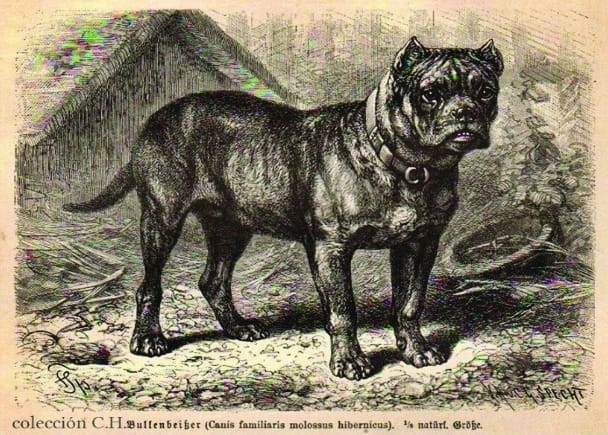The Boerboel: a name synonymous with strength, loyalty, and a rich history as captivating as its South African homeland. This article delves into the fascinating story of the Boerboel, from its ancient origins to its modern-day presence as a cherished companion and guardian.
History of the Boerboel
The Boerboel’s story likely began centuries ago with the formidable war dogs of Assyria. These powerful canines probably migrated across continents as empires rose and fell, their bloodlines intertwining with those of other breeds they encountered. Some historians even suggest that Phoenicians, renowned for their seafaring prowess, may have introduced these canines to Africa around 600 AD.
Fast forward to the 17th century, when Dutch, German, and Huguenot settlers arrived in South Africa. Facing a wild and unpredictable landscape, these settlers needed a protector—a guardian capable of defending their families and livestock. They found this protector in the Boerboel, whose ancestors had already proven their mettle in harsh environments.
The name “Boerboel” itself speaks volumes about their purpose. “Boer,” meaning farmer, reflects their integral role in the lives of these early settlers. Boerboels were more than mere pets; they were indispensable working companions.
Over generations, selective breeding honed the Boerboel’s characteristics, emphasizing strength, bravery, and intelligence. This wasn’t about creating a show dog but about cultivating a steadfast, intuitive protector for farms and families.
While the Boerboel has a long history in South Africa, its global recognition is a relatively recent development. In the 21st century, the breed’s exceptional qualities captivated canine enthusiasts worldwide. Finally, in 2015, the American Kennel Club officially recognized the Boerboel, solidifying its place among the world’s most esteemed breeds.
Today, the Boerboel graces homes and hearts around the globe. While their farmhand days may be largely behind them, the spirit of their ancestors still burns bright. They are cherished for their loyalty, intelligence, and gentle nature—all while carrying the legacy of courage and resilience essential for survival.
Where do Boerboels originate from?
The Boerboel, a breed known for its impressive stature and loyalty, hails from South Africa. Its story begins in the 17th century when Dutch, German, and Huguenot settlers arrived, bringing with them their trusty mastiffs and bulldogs. These powerful dogs were essential for protection and herding in this new land.
Over time, these European breeds intermingled with local African dogs, eventually giving rise to the Boerboel we know today. The name “Boerboel” literally translates to “farmer’s dog” in Afrikaans, aptly describing their original role. These dogs were the quintessential farmhands, guarding livestock, protecting property, and serving as loyal companions.
While the exact blend of breeds that resulted in the Boerboel remains a topic of debate among experts, their ancestry is undoubtedly a melting pot of strength and resilience. The Boerboel stands as a testament to the adaptability of these early settlers’ dogs, which evolved over generations into a unique and beloved breed. Today, Boerboels are cherished worldwide, still carrying the loyalty and protective instincts that made them invaluable centuries ago.
What two breeds make a Boerboel?
The Boerboel’s exact origins remain shrouded in some mystery, but most experts agree that mastiff and bulldog breeds played a significant role in their development. When Dutch settlers arrived in South Africa in the 17th century, they needed dogs capable of guarding their farms and assisting with tasks like hunting large animals. Mastiffs and bulldogs, known for their strength and courage, were ideal candidates.
Over time, these European breeds likely interbred with other dogs brought from Europe, gradually shaping the Boerboel. This genetic blend likely contributed to the breed’s impressive size, with males reaching up to 200 pounds.
Beyond their size, their distinctive appearance—short, dense coats in various colors, large heads, broad muzzles, and powerful jaws—reflects their mastiff and bulldog ancestry. Despite their imposing physique, Boerboels are renowned for their loyalty, protectiveness, and gentle nature, especially towards children. While the exact recipe for the Boerboel may never be fully known, the influence of mastiff and bulldog ancestors is undeniable, resulting in a breed that is both powerful and gentle.
What was the original Boerboel?
To understand the original Boerboel, we journey back to ancient Assyria, where their ancestors likely roamed. Over time, these dogs journeyed across continents, eventually accompanying Dutch, German, and Huguenot settlers to South Africa. These settlers sought protection and companionship in a challenging and often dangerous new world, and they found it in the Boerboel.
Life in early South Africa was demanding. The Boerboel, however, thrived. These dogs possessed remarkable strength, courage, and adaptability. They guarded livestock from predators, protected homesteads, and even took part in big game hunts, proving themselves capable of handling any challenge.
The Boerboel’s exceptional abilities did not go unnoticed. As word spread, the value of such a loyal and fearless dog became clear, leading to the establishment of the South African Boerboel Breeders Association (SABT/SABBA) in 1983. This organization aimed to preserve the breed’s unique characteristics and safeguard its future, creating a standardized foundation stock and laying the groundwork for responsible breeding practices.
The Boerboel of today stands as a tribute to its ancestors, embodying their resilience, courage, and unwavering loyalty. Whether as guardians, working partners, or beloved family members, Boerboels continue to make their mark on the world, carrying a legacy etched in history.
Are Boerboels Legal in the US?
Boerboels are generally legal to own in most of the United States; however, it’s crucial to remember that local laws can vary. For example, Fairfield, Iowa, has implemented a ban on Boerboels within city limits, likely due to concerns stemming from the breed’s size and strength. Always research and understand your local ordinances before bringing a Boerboel home.
The American Kennel Club (AKC) officially recognized the Boerboel in 2015, a significant milestone for the breed. The American Boerboel Club, established in 2014, plays a crucial role in promoting responsible breeding practices and has established a strict breed standard to maintain the Boerboel’s unique characteristics. Reputable breeders adhere to a code of ethics, which includes refraining from publicly displaying the prices of their dogs to discourage irresponsible breeding.
For those interested in learning more about Boerboels, the AKC website is an excellent resource, providing comprehensive information about the breed’s history, temperament, and care requirements.
Can a Pitbull Defeat a Boerboel?
The question of whether a Pitbull could defeat a Boerboel in a fight is a complex one with no easy answer. Let’s explore some of the factors at play.
Size and Strength: Boerboels have a considerable size advantage, often weighing between 150-200 pounds, compared to a Pitbull’s average of 30-65 pounds. In a physical confrontation, size and strength often play a significant role.
Intelligence and Temperament: Boerboels are generally known for their calm and collected nature, while Pitbulls, while loyal and intelligent, can be more reactive. This difference in temperament could influence their fighting styles.
Training and Socialization: Both breeds require proper training and socialization from an early age. A well-trained dog is less likely to engage in aggressive behavior, regardless of breed.
Unpredictability: It’s crucial to remember that predicting the outcome of any fight is nearly impossible. Numerous variables are involved, including the individual dogs’ ages, experiences, and the environment in which a confrontation might occur.
Ultimately, it’s essential to remember that dog fighting is both illegal and inhumane. The focus should always be on responsible ownership, proper training, and ensuring the safety and well-being of these remarkable animals.
What is the life expectancy of a Boerboel?
The average lifespan of a Boerboel is around 10 to 12 years, placing them within a typical range for dog breeds. However, many factors can influence a Boerboel’s lifespan, including genetics, diet, exercise, and overall health care.
Like many large breed dogs, Boerboels can be prone to certain health conditions, such as hip and elbow dysplasia, which can impact their quality of life and potentially shorten their lifespan.
Regular veterinary check-ups, a balanced diet, adequate exercise, and a loving home environment all contribute to a long and healthy life for your Boerboel.
What is the disadvantage of a Boerboel dog?
While Boerboels make incredible companions, it’s essential to consider both the advantages and disadvantages of owning such a powerful breed:
Training and Socialization: Boerboels require extensive and ongoing training and socialization from puppyhood. Their strong protective instincts, while valuable, necessitate careful guidance to manage potential aggression towards strangers or other animals.
Space Requirements: Their size means they are not suited to apartment living. They need space to exercise and thrive, making a house with a yard ideal.
Health Issues: Like all breeds, Boerboels are prone to certain health conditions, such as hip and elbow dysplasia. These can lead to costly vet bills and require owners to be prepared for potential health challenges.
Territorial Instincts: Boerboels’ natural guarding instincts, while beneficial, also mean they can be wary of strangers. Early socialization is key, but owners must be prepared to manage their dog’s territorial behavior.
Owning a Boerboel is a significant commitment. They require experienced owners dedicated to providing proper training, socialization, and care.
Is a Boerboel a rare breed?
While Boerboels are gaining recognition worldwide, they are still considered a relatively rare breed, especially when compared to more popular breeds like Golden Retrievers or Labradors.
Several factors contribute to their rarity. Despite efforts to increase their numbers, breeding programs, particularly in their native South Africa, have not been as successful as hoped. Additionally, their demanding nature—requiring experienced owners dedicated to training and socialization—makes them a less common choice for first-time dog owners.
Their rarity is unfortunate, as Boerboels offer a unique combination of desirable traits. They are highly intelligent, protective, and versatile, excelling in obedience, weight-pulling competitions, and even therapy work. Their loyalty and affection for children also make them wonderful family companions, provided they receive proper training and socialization.
The Boerboel’s history and lineage remain somewhat shrouded in mystery. While their exact ancestry may be debated, their remarkable blend of strength, loyalty, and gentleness has solidified their place as a truly exceptional breed.
Are black Boerboels pure?
The question of whether black Boerboels are “purebred” sparked debate and controversy within the Boerboel community for a time. However, the answer is a resounding yes.
Black Boerboels have existed for centuries, and communities in South Africa prized them for their loyalty and protectiveness. However, in a controversial move, the official animal registry in 2015 decided to exclude black as an accepted color for the breed.
This decision was met with resistance from Boerboel enthusiasts and breeders who recognized the historical significance and genetic validity of black Boerboels. The South African Boerboel Breeders’ Society (SABBS), alongside dedicated breeders, challenged the decision, and in a victory for the breed, the black Boerboel was officially reinstated in 2017.
Scientific evidence played a key role in overturning the initial exclusion. Genetic studies confirmed that black Boerboels share the same genetic makeup as their counterparts, proving their rightful place within the breed.
Today, black Boerboels are recognized as a valuable part of the breed, cherished for their working abilities and unique heritage. Their story serves as a testament to the importance of scientific accuracy and the dedication of breeders in preserving the integrity of a breed.
Are Boerboels bigger than Rottweilers?
When comparing size, Boerboels are generally larger than Rottweilers. While their height at the shoulder can be similar, ranging from 22-27 inches for both breeds, Boerboels are significantly heavier. Male Boerboels can weigh upwards of 200 pounds, while male Rottweilers typically average around 135-145 pounds.
Visually, Boerboels tend to have a stockier build than Rottweilers, with wider chests and heavier bone structures, contributing to their imposing appearance.
It’s important to note that size can vary within any breed, and you might encounter a particularly large Rottweiler or a more slender Boerboel. However, on average, Boerboels claim the title of the larger breed.
Regardless of size, both Boerboels and Rottweilers are powerful dogs requiring experienced owners. Thorough research into their temperament, exercise needs, and training requirements is essential before welcoming either breed into your home.
Explore More About Fascinating Dog Breeds:
- Fayette County PVA Assessments Soar in 2024: What Lexington, KY Homeowners Need to Know - November 22, 2024
- Carteret County Register of Deeds: Your Guide to Land Records & Vital Documents in Beaufort, NC - November 22, 2024
- Access DuPage County Property Records Online: A Comprehensive Guide - November 22, 2024















